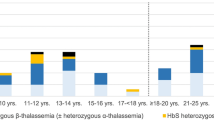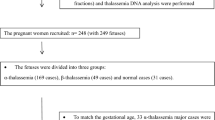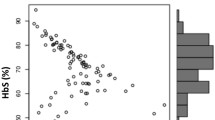Abstract
Objective
It has been shown that hemoglobinopathies increase the risk of pregnancy complications and placental dysfunction. This could alter the placental analytes examined during prenatal aneuploidy screening. Our objective was to determine whether there is a difference in maternal serum screening results for women with hemoglobin S variants (AS, SS, SC, S/beta thalassemia) compared with women with normal hemoglobin (AA).
Study design
This is a retrospective cohort study in African–American women receiving aneuploidy screening at MedStar Washington Hospital Center from 2008 to 2015. We evaluated 79 women with hemoglobin S variants (69 AS and 10 sickle cell disease (SCD)) and 79 controls. Descriptive statistics (means, medians, and frequencies) were calculated for each group. For the continuous variables, differences in the averages between the two groups were tested using the t test or Wilcoxon rank sum test. Differences in the averages between three or more groups were tested using the analysis of variance test or the Kruskal–Wallis test.
Results
Demographics were similar between cases and controls. The overall screen positive rate for Down syndrome among patients with sickle cell trait (AS) was 3% (2/69). For patients with SCD, the overall screen positive rate was 10% (1/10). None of the women in the control population (AA) has a positive Down syndrome screening result (0/79).
Conclusion
As expected, the screen positive rate in patients with hemoglobin S variants was higher than controls, however, patients with sickle cell trait do not appear to be at an increased risk for false-positive results with serum aneuploidy screening compared with the general population. We did, however, find an increased risk of false-positive quad screen results in patients with sickle cell disease.
This is a preview of subscription content, access via your institution
Access options
Subscribe to this journal
Receive 12 print issues and online access
$259.00 per year
only $21.58 per issue
Buy this article
- Purchase on Springer Link
- Instant access to full article PDF
Prices may be subject to local taxes which are calculated during checkout
Similar content being viewed by others
References
ACOG Committee on Obstetrics. ACOG Practice Bulletin No. 78: hemoglobinopathies in pregnancy. Obstet Gynecol. 2007;109:229–37.
Barfield WD, Barradas DT, Manning SE, Kotelchuck M, Shapiro-Mendoza CK. Sickle cell disease and pregnancy outcomes: women of African descent. Am J Prev Med. 2010;38:S542–9.
Oteng-Ntim E, Meeks D, Seed PT, Webster L, Howard J, Doyle P, et al. Adverse maternal and perinatal outcomes in pregnant women with sickle cell disease: systematic review and meta-analysis. Blood. 2015;125:3316–25.
Larrabee KD, Monga M. Women with sickle cell trait are at increased risk for preeclampsia. Am J Obstet Gynecol. 1997;177:425–8.
Tita AT, Biggio JR, Chapman V, Neely C, Rouse DJ. Perinatal and maternal outcomes in women with sickle or hemoglobin C trait. Obstet Gynecol. 2007;110:1113–9.
Practice Bulletin No. 163. Summary: screening for fetal aneuploidy. Obstet Gynecol. 2016;127:979–81.
Dugoff L. Society for Maternal-Fetal Medicine. First- and second-trimester maternal serum markers for aneuploidy and adverse obstetric outcomes. Obstet Gynecol. 2010;115:1052–61.
Gagnon A, Wilson RD, Audibert F, Allen VM, Blight C, Brock JA, et al. Obstetrical complications associated with abnormal maternal serum markers analytes. J Obstet Gynaecol Can. 2008;30:918–49.
Baer RJ, Currier RJ, Norton ME, Flessel MC, Goldman S, Towner D, et al. Obstetric, perinatal, and fetal outcomes in pregnancies with false-positive integrated screening results. Obstet Gynecol. 2014;123:603–9.
Trampont P, Roudier M, Andrea AM, Nomal N, Mignot TM, Leborgne-Samuel Y, et al. The placental-umbilical unit in sickle cell disease pregnancy: A model for studying in vivo functional adjustments to hypoxia in humans. Hum Pathol. 2004;35:1353–9.
Benn PA, Ying J, Beazoglou T, Egan JF. Estimates for the sensitivity and false-positive rates for second trimester serum screening for Down syndrome and trisomy 18 with adjustment for cross-identification and double-positive results. Prenat Diagn. 2001;21:46–51.
Spencer K. Age related detection and false positive rates when screening for Down’s syndrome in the first trimester using fetal nuchal translucency and maternal serum free beta hCG and PAPP-A. BJOG. 2001;108:1043–6.
Kneitel AW, Rhee-Morris L, Obadia R, Towner D. Increased false positive Down syndrome screening in women with sickle cell anemia. Prenat Diagn. 2015;35:797–800.
Palomaki GE, Lambert-Messerlian GM, Canick JA. A summary analysis of down syndrome markers in the late first trimester. Adv Clin Chem. 2007;43:177–210.
Rathod KB, Jaiswal KN, Shrivastava AC, Shrikhande AV. Study of placenta in sickle cell disorders. Indian J Pathol Microbiol. 2007;50:698–701.
Banerjee S, et al. “Placental Morphogenesis in Pregnancies with Down’s Syndrome might Provide a Clue to Pre-Eclampsia”. Placenta. 2002;23:172–4.
Sherer DM, Abulafia O. Angiogenesis during implantation, and placental and early embryonic development. Placenta. 2001;22:1–13.
Sickle Cell Disease (SCD). Centers for Disease Control and Prevention. 2016; Available at: www.cdc.gov/ncbddd/sicklecell/data.html. Accessed 31 August 2017.
Serjeant GR, Vichinsky E. Variability of homozygous sickle cell disease: The role of alpha and beta globin chain variation and other factors. Blood Cells Mol Dis. 2017;70:66–77.
Acknowledgements
We thank Eshetu Tefera, M.S, and the Medstar Health Research Institute for statistical support.
Author information
Authors and Affiliations
Corresponding author
Ethics declarations
Conflict of interest
The authors declare that they have no conflict of interest.
Rights and permissions
About this article
Cite this article
Adams, A.D., Schaa, K. & Overcash, R.T. Differences in prenatal aneuploidy screening among African–American women with hemoglobin S variants. J Perinatol 38, 797–803 (2018). https://doi.org/10.1038/s41372-018-0159-y
Received:
Revised:
Accepted:
Published:
Issue Date:
DOI: https://doi.org/10.1038/s41372-018-0159-y



